10.Cache Memory
A Basic Hardware Cache Design
We will start with a basic hardware cache design
Then, we will examine a multitude of ideas to make it better
Blocks and Addressing the Cache
Memory is logically divided into fixed-size blocks
Each block maps to a location in the cache, determined by
the index bitsin the addressused to index into the tag and data stores\

Cache access:
index into the tag and data stores with index bits in address
check valid bit in tag store
compare tag bits in address with the stored tag in tag store
If a block is in the cache (cache hit), the stored tag should be valid and match the tag of the block
Direct-Mapped Cache
Assume byte-addressable memory: 256 bytes, 8-byte blocks -> 32 blocks
Assume cache: 64 bytes, 8 blocks
Direct-mapped: A block can go to only one location\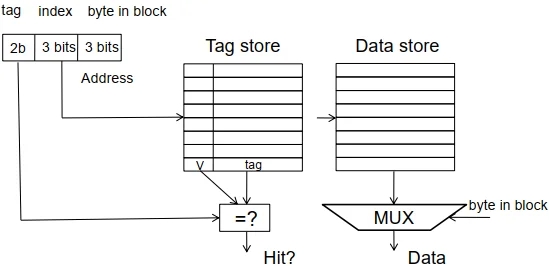
Addresses with same index contend for the same location
Cause conflict misses
Direct-mapped cache: Two blocks in memory that map to the same index in the cache cannot be present in the cache at the same time
One index one entry
Can lead to 0% hit rate if more than one block accessed in an interleaved manner map to the same index
Assume addresses A and B have the same index bits but different tag bits
A, B, A, B, A, B, A, B, … conflict in the cache index
All accesses are conflict misses
Set Associativity
Addresses 0 and 8 always conflict in direct mapped cache
Instead of having one column of 8, have 2 columns of 4 blocks
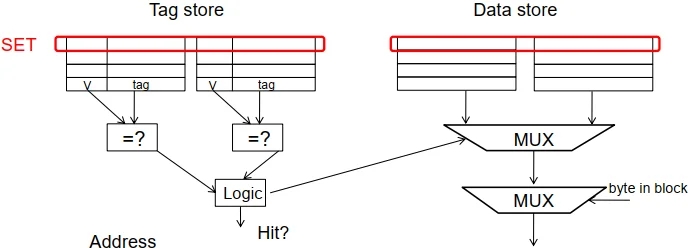
Key idea: Associative memory within the set
+Accommodates conflicts better (fewer conflict misses)
--More complex, slower access, larger tag store
Higher Associativity
4-way
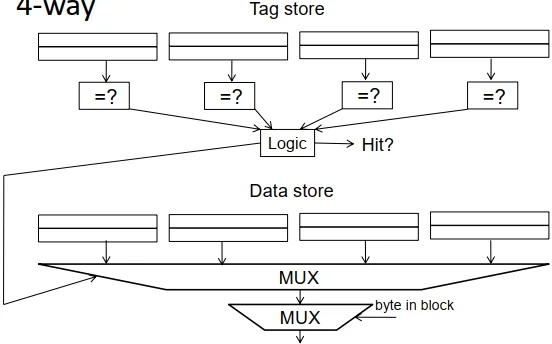
+Likelihood of conflict misses even lower
--More tag comparators and wider data mux; larger tags
Full Associativity
Fully associative cache
A block can be placed in any cache location
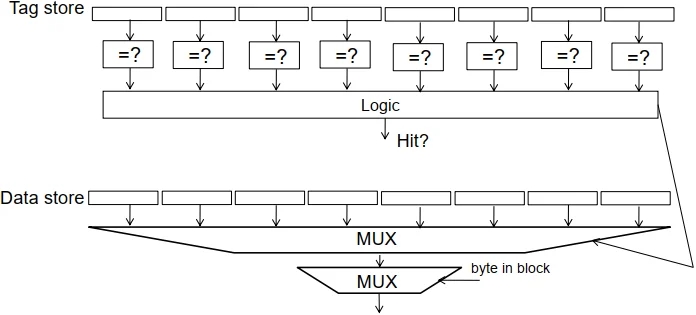
Associativity (and Tradeoffs)
Degree of associativity: How many blocks can map to the same set?
Higher associativity
++ Higher hit rate
-- Slower cache access time (hit latency and data access latency)
-- More expensive hardware (more comparators)
Diminishing returns from higher associativity
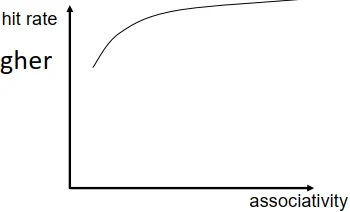
Issues in Set-Associative Caches
Think of each block in a set having a “priority”
Indicating how important it is to keep the block in the cache
Key issue:
How do you determine block priorities?There are three key decisions can adjust priority:
Insertion, promotion, eviction (replacement)
Insertion: What happens to priorities on a cache fill?
Where to insert the incoming block, whether or not to insert the block
Promotion: What happens to priorities on a cache hit?
Whether and how to change block priority
Eviction/replacement: What happens to priorities on a cache miss?
Which block to evict and how to adjust priorities
Here we talk about: Replacement Policy
Which blockin the setto replaceon a cache miss?Any invalid block first
If all are valid, consult the
replacement policyRandom
FIFO
LRU: Least recently used (how to implement?)NRU: Not most recently used
LFU: Least frequently used?
Least costly to re-fetch?
Why would memory accesses have different cost?
Hybrid replacement policies
Optimal replacement policy?
Implementing LRU
Idea: Evict the least recently accessed block
Problem: Need to keep track of access ordering of blocks
Question: 2-way set associative cache:
How to implement LRU perfectly?
Question: 4-way set associative cache:
How to implement LRU perfectly?
How many different orderings possible for the 4 blocks in the set?
How many bits needed to encode the LRU order of a block?
What is the logic needed to determine the LRU victim?
Approximations of LRU
Most modern processors do not implement “true LRU” (also called “perfect LRU”) in highly-associative caches
Why?
True LRU is complex
LRU is an approximation to predict locality anyway (i.e., not the best possible cache management policy)
Alternative examples:
Not MRU (not most recently used)
Hierarchical LRU: divide the 4-way set into 2-way “groups”, track the MRU group and the MRU way in each group
Victim-NextVictim Replacement: Only keep track of the victim and the next victim
LRU or Random
LRU vs. Random: Which one is better?
Example: 4-way cache, cyclic references to A, B, C, D, E
0% hit rate with LRU policy
Set thrashing: When the “program working set” in a set is larger than set associativity
Random replacement policy is better when thrashing occurs
In practice:
Depends on workload
Average hit rate of LRU and Random are similar
Best of both Worlds: Hybrid of LRU and Random
How to choose between the two? Set sampling
See Qureshi et al., “A Case for MLP-Aware Cache Replacement,“ ISCA 2006
What Is the Optimal Replacement Policy
Belady’s OPT
Replace the block that is going to be referenced furthest in the future by the program
Belady, “
A study of replacement algorithms for a virtualstorage computer,” IBM Systems Journal, 1966.How do we implement this? Simulate?
Is this optimal for minimizing miss rate?
Is this optimal for minimizing execution time?
No. Cache miss latency/cost varies from block to block!
Two reasons: Remote vs. local caches and miss overlapping
Qureshi et al. “
A Case for MLP-Aware Cache Replacement,“ ISCA 2006
Cache versus Page Replacement
Physical memory (DRAM) is a cache for disk
Usually managed by system software via the virtual memory subsystem
Page replacement is similar to cache replacement
Page table is the “tag store” for physical memory data store
What is the difference?
Access speed: cache vs. physical memory
Number of blocks in a cache vs. physical memory
“Tolerable” amount of time to find a replacement candidate
Role of hardware versus software
What’s in A Tag Store Entry
Valid bit
Tag
Replacement policy bits
Dirty bit?
Write back vs. write through caches
Handling Writes (I)
When do we write the modified data in a cache to the next level?
Write through: At the time the write happens
Write back: When the block is evicted
Write-back
Can consolidate multiple writes to the same block before eviction
Potentially saves bandwidth between cache levels + saves energy
Need a bit in the tag store indicating the block is “dirty/modified”
Write-through
Simpler
All levels are up to date. Consistency: Simpler cache coherence because no need to check lower-level caches
More bandwidth intensive; no coalescing of writes
Handling Writes (II)
Do we allocate a cache block on a write miss?
Allocate on write miss: Yes
No-allocate on write miss: No
Allocate on write miss
Can consolidate writes instead of writing each of them individually to next level
Simpler because write misses can be treated the same way as read misses
Requires (?) transfer of the whole cache block
No-allocate
Conserves cache space if locality of writes is low (potentially better cache hit rate)
Sectored Caches
Idea: Divide a block into sub-blocks (or sectors)
Have separate valid and dirty bits for each sector
When is this useful? (
Think writes…)No need to transfer entire cache block into cache
A write simply validates and updates a sub-block
More freedom in transferring sub-blocks into cache
How many sub-blocks do you transfer on a read?
More complex design
May not exploit spatial locality fully for reads

Instruction vs. Data Caches
Separate or Unified?
Unified:
Dynamic sharing of cache space: no overprovisioning that might happen with static partitioning (i.e., split I and D caches)
Instructions and data can thrash each other (i.e., no guaranteed space for either)
I and D are accessed in different places in the pipeline. Where do we place the unified cache for fast access?
First level caches are almost always split
Mainly for the last reason above
Second and higher levels are almost always unified
Multi-level Caching in a Pipelined Design
First-level caches (instruction and data)
Decisions very much affected by cycle time
Small, lower associativity
Tag store and data store accessed in parallel
Second-level caches
Decisions need to balance hit rate and access latency
Usually large and highly associative; latency not as important
Tag store and data store accessed serially
Serial vs. Parallel access of levels
Serial: Second level cache accessed only if first-level misses
Second level does not see the same accesses as the first
First level acts as a filter (filters some temporal and spatial locality)
Management policies are therefore different
Cache Performance
Cache Parameters vs. Miss/Hit Rate
Cache size
Block size
Associativity
Replacement policy
Insertion/Placement policy
Cache Size
Cache size: total data (not including tag) capacity
bigger can exploit temporal locality better
not ALWAYS better
Too large a cache adversely affects hit and miss latency
smaller is faster => bigger is slower
access time may degrade critical path
Too small a cache
doesn’t exploit temporal locality well
useful data replaced often
Working set: the whole set of data the executing application references
Within a time interval
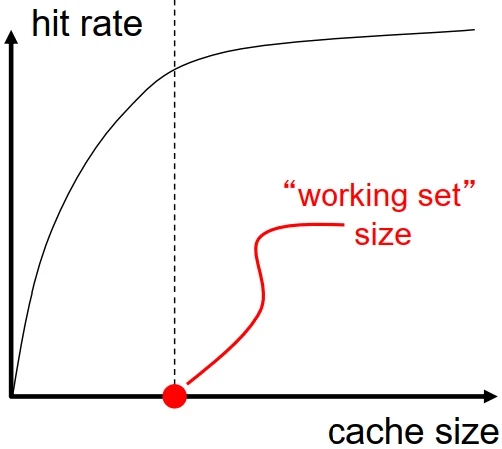
Block Size
Block size is the data that is associated with an address tag
not necessarily the unit of transfer between hierarchies
Sub-blocking: A block divided into multiple pieces (each with V bit)
Can improve “write” performance
Too small blocks
don’t exploit spatial locality well
have larger tag overhead
Too large blocks
too few total # of blocks less
temporal locality exploitation
waste of cache space and bandwidth/energy
if spatial locality is not high

Large Blocks: Critical-Word and Sub-blocking
Large cache blocks can take a long time to fill into the cache
fill cache line critical word first
restart cache access before complete fill
Large cache blocks can waste bus bandwidth
divide a block into sub-blocks
associate separate valid bits for each sub-block
When is this useful?

Associativity
How many blocks can map to the same index (or set)?
Larger associativity
lower miss rate, less variation among programs
diminishing returns, higher hit latency
Smaller associativity
lower cost
lower hit latency
Especially important for L1 caches
Power of 2 required?
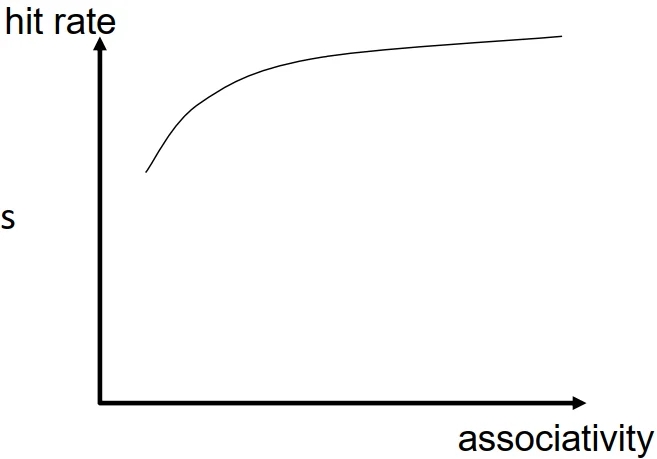
Classification of Cache Misses
Compulsory miss
first reference to an address (block) always results in a miss
subsequent references should hit unless the cache block is displaced for the reasons below
Capacity miss
cache is too small to hold everything needed
defined as the misses that would occur even in a fullyassociative cache (with optimal replacement) of the same capacity
Conflict miss
defined as any miss that is neither a compulsory nor a capacity miss
How to Reduce Each Miss Type
Compulsory
Caching cannot help
Prefetching can help
Conflict
More associativity
Other ways to get more associativity without making the cache associative
Victim cache
Hashing
Software hints?
Capacity
Utilize cache space better: keep blocks that will be referenced
Software management: divide working set such that each “phase” fits in cache
Improving Cache “Performance”
Remember
Average memory access time (AMAT)
= ( hit-rate * hit-latency ) + ( miss-rate * miss-latency )
Reducing miss rate
Remind: reducing miss rate can reduce performance if more costly-to-refetch blocks are evicted
Reducing miss latency/cost
Reducing hit latency/cost
Improving Basic Cache Performance
Reducing miss rate
More associativity
Alternatives/enhancements to associativity
Victim caches, hashing, pseudo-associativity, skewed associativity
Better replacement/insertion policies
Software approaches
Reducing miss latency/cost
Multi-level caches
Critical word first
Subblocking/sectoring
Better replacement/insertion policies
Non-blocking caches (multiple cache misses in parallel)
Issues in multicore caches
Last updated